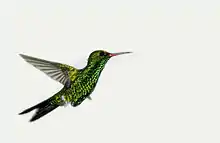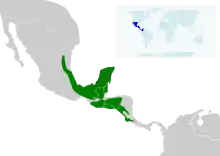Canivet's emerald
Canivet's emerald (Cynanthus canivetii) or the fork-tailed emerald, is a species of hummingbird in the family Trochilidae. It is found in Belize, Costa Rica, El Salvador, Guatemala, Honduras, Mexico, and Nicaragua. Its natural habitats are subtropical or tropical dry forest, subtropical or tropical moist lowland forest, and heavily degraded former forest.
| Canivet's emerald | |
|---|---|
 | |
| A male in Ulita, Honduras | |
| Scientific classification | |
| Kingdom: | Animalia |
| Phylum: | Chordata |
| Class: | Aves |
| Order: | Apodiformes |
| Family: | Trochilidae |
| Genus: | Cynanthus |
| Species: | C. canivetii |
| Binomial name | |
| Cynanthus canivetii (Lesson, 1832) | |
 | |
| Range of C. canivetii | |
The common name and Latin binomial commemorate the French ornithologist Emmanuel Canivet de Carentan.[2]
Description
Canivet's emerald grows to a length of 8 cm (3.1 in) and weighs 2.3–2.5 g (0.081–0.088 oz).[3][4] The male is metallic green with a forked blue-black tail. The female is green above and grey below, with a dark eye mask topped by a white stripe behind the eye. They are virtually identical to the garden emerald, with the exception of bill colour; Garden has an entirely black bill while Canivet's has a red-based bill with a black tip. The two species have no overlap in their ranges.
Taxonomy
The subspecies C. c. salvini, which occupies the southern part of the range from extreme south of Mexico to Costa Rica, is sometimes split as Salvin's emerald.
References
- BirdLife International (2012). "Chlorostilbon canivetii". IUCN Red List of Threatened Species. 2012. Retrieved 26 November 2013.CS1 maint: ref=harv (link)
- Beolens, Bo; Watkins, Michael (2003). Whose Bird? Men and Women Commemorated in the Common Names of Birds. London: Christopher Helm. p. 76.
- Garrigues, Richard; Dean, Robert (2007). The Birds of Costa Rica. Ithaca: Zona Tropical/Comstock/Cornell University Press. p. 126. ISBN 978-0-8014-7373-9.
- Arizmendi, M.C.; Rodríguez-Flores, C.; Sedgwick, Carolyn; Schulenberg, Thomas S. (2013). Schulenberg, T.S. (ed.). "Overview – Canivet's Emerald (Chlorostilbon canivetii)". Neotropical Birds Online. Ithaca: Cornell Lab of Ornithology. Retrieved 12 July 2014.
External links
| Wikimedia Commons has media related to Chlorostilbon canivetii. |
| Wikispecies has information related to Chlorostilbon canivetii. |
- Canivet's Emerald photo gallery at VIREO (Drexel University)
